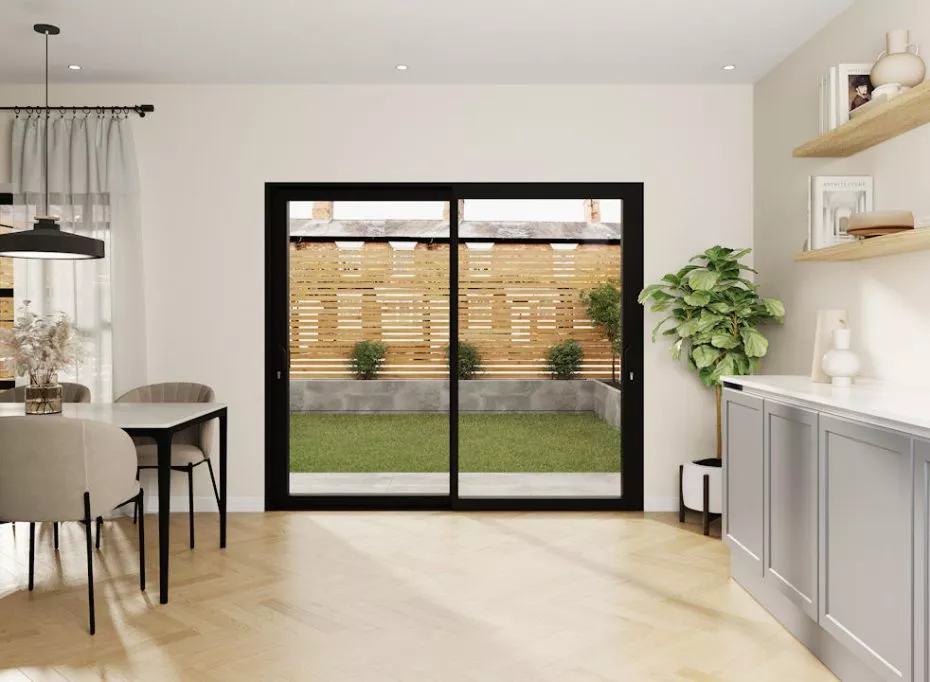What are aluminium sliding door thermal breaks?
Energy efficiency and sustainability continue to be key considerations for homes and commercial spaces. Aluminium bifold doors with thermal breaks not only enhance the aesthetic appeal of a building but also provide exceptional insulation and energy-saving benefits.
This guide will explain what thermal breaks are, how they work, and why they are essential for aluminium sliding doors.
Click on a link to jump to that section:
An introduction to thermal breaks and why they matter in aluminium door frames.
A look at the science behind how thermal breaks prevent heat transfer through aluminium.
Discover how these doors improve insulation, comfort, and energy efficiency.
An overview of the most common materials used to create effective thermal breaks.
Key reasons to opt for thermally broken doors in modern home design.
A side-by-side comparison to help you understand performance differences.
Quick answers to common questions about thermal breaks and aluminium sliding doors.
What are thermal breaks in aluminium sliding doors?
Thermal breaks are a vital component in aluminium sliding doors, designed to improve their thermal performance. A thermal break refers to a layer of material with low thermal conductivity that separates the interior and exterior sections of an aluminium frame. This creates a barrier that reduces heat transfer, ensuring the door remains energy-efficient.
Aluminium is an excellent material for doors due to its strength, durability, and slim design. However, it is also a highly conductive metal, which means it readily transfers heat and cold. Without a thermal break, aluminium doors can allow heat to escape during winter and enter during summer, reducing energy efficiency and comfort. By incorporating a thermal break, manufacturers address this issue effectively, making aluminium sliding doors a practical choice for energy-conscious homeowners.
How do thermal breaks work?
The concept behind thermal breaks is simple but effective. Aluminium door frames consist of two sections: one exposed to external conditions and the other facing the interior. A thermal break separates these two sections using a material that doesn’t conduct heat well, such as polyamide or insulating foam.
This separation prevents heat transfer between the interior and exterior of the door. In winter, thermal breaks keep the warmth inside, reducing reliance on heating systems. In summer, they block external heat from entering, maintaining a cooler indoor environment. Additionally, they help prevent condensation by keeping interior surfaces warmer and minimising moisture build-up.

Benefits of aluminium sliding doors with thermal breaks
Enhanced energy efficiency
Thermal breaks significantly improve the insulation properties of aluminium sliding doors. By reducing heat transfer, they help maintain a consistent indoor temperature, reducing the need for heating in winter and cooling in summer. This results in lower energy bills and a reduced carbon footprint. Find out more about choosing thermally efficient sliding doors.
Increased comfort
With thermal breaks, aluminium sliding doors ensure a comfortable indoor environment year-round. The improved insulation minimises temperature fluctuations, creating a stable and pleasant living or working space.
Sustainability
Energy efficiency isn’t just good for your wallet—it’s also great for the planet. By reducing energy consumption, aluminium doors with thermal breaks contribute to more sustainable living. Many manufacturers also use recyclable materials, enhancing the eco-friendliness of these doors.
Condensation prevention
Condensation can lead to issues like mould growth, which impacts both aesthetics and health. Thermal breaks reduce the likelihood of condensation by maintaining a warmer surface temperature on the interior of the aluminium frame.
Durability and longevity
Aluminium is naturally robust and resistant to warping, rust, and corrosion. Thermal breaks enhance this durability by ensuring the frame doesn’t become a weak point for temperature-related stress, extending the door’s lifespan.
Aesthetic flexibility
Thermal breaks enable manufacturers to retain the slim, elegant profiles of aluminium sliding doors without compromising performance. This allows homeowners to enjoy expansive glass panels and modern designs while benefitting from superior insulation.
Bring in more natural light with the Supreme sliding door range
Our modern Supreme aluminium sliding doors are popular choice for many homeowners due to their sleek appearance, durability, and energy efficiency. They are made with high-quality, low maintenance aluminium frames.
These eye-catching modern external sliding door systems are supplied with low-emissivity (low-E) glass, and thermal breaks to further improve their impressive insulation and energy efficiency. Offering U-Values of only 1.6 W/m2K, you are guaranteed exceptional thermal efficiency for your home with our Supreme aluminium sliding door range.
From £2349

Materials used for thermal breaks
The most common material used for thermal breaks is polyamide, a type of durable plastic known for its excellent insulating properties. Polyamide strips are inserted between the interior and exterior sections of the aluminium frame, providing a reliable thermal barrier.
In some advanced systems, insulating foam or resin may also be used. These materials offer additional insulation and are particularly effective in achieving low U-values (a measure of thermal performance). Manufacturers choose these materials for their ability to maintain structural integrity while delivering outstanding thermal efficiency. Read more about understanding sliding door U-values here.
Why choose aluminium sliding doors with thermal breaks?
Aluminium sliding doors are a top choice for many homeowners, architects, and builders due to their sleek design and practical benefits. When enhanced with thermal breaks, they become an even more attractive option.
Strength and durability
Aluminium is a highly robust material that can support large glass panels, making it ideal for sliding doors. Its resistance to warping, rust, and corrosion ensures long-lasting performance, even in harsh climates.
Slim profiles and large glass areas
One of the standout features of aluminium sliding doors is their ability to accommodate slim frames and expansive glass panels. This creates an unobstructed view of the outdoors and allows natural light to flood the interior.
Customisation options
Aluminium sliding doors offer extensive customisation options, including colours, finishes, and configurations. Whether you prefer a minimalist matte black or a bold dual-tone finish, there’s an option to suit every aesthetic.
Low maintenance
Compared to materials like timber, aluminium requires minimal upkeep. Thermal breaks enhance this advantage by reducing the risk of temperature-related damage, further simplifying maintenance.

Comparing aluminium sliding doors with and without thermal breaks
The inclusion of thermal breaks sets aluminium sliding doors apart from their counterparts.
|
Feature |
With Thermal Breaks |
Without Thermal Breaks |
|---|---|---|
|
Insulation |
High level of thermal insulation |
Poor insulation; significant heat transfer |
|
Energy Efficiency |
Reduced energy bills and carbon footprint |
Increased reliance on heating and cooling |
|
Comfort |
Stable indoor temperatures year-round |
Temperature fluctuations |
|
Condensation prevention |
Minimal risk of condensation |
Higher likelihood of condensation |
|
Suitability |
Ideal for modern, energy-efficient buildings |
Less suitable for climates with temperature extremes |
Frequently asked questions
What is the purpose of a thermal break?
A thermal break creates a barrier within the aluminium frame to reduce heat transfer and improve energy efficiency.
Are aluminium doors with thermal breaks more expensive?
These doors are typically more expensive than those without thermal breaks due to the additional materials and manufacturing processes. However, the energy savings and durability they provide make them a worthwhile investment.
How do thermal breaks prevent condensation?
By keeping the interior frame warmer, thermal breaks reduce the likelihood of moisture forming on the surface, preventing condensation.
Are thermal breaks visible in the finished door?
Thermal breaks are concealed within the frame, ensuring they don’t impact the door’s appearance.
RELATED CONTENT

About John Collins
John has built Vufold into a unique online door and window company and has spent 20 years bringing innovative products and designs to fruition, recognising niches in the market and placing them in the likes of Wickes and Travis Perkins, he started Vufold in order to sell them directly. John founded Vufold and has amassed a wealth of experience in product design and development, and in particular timber-based products
Read more about John Collins

